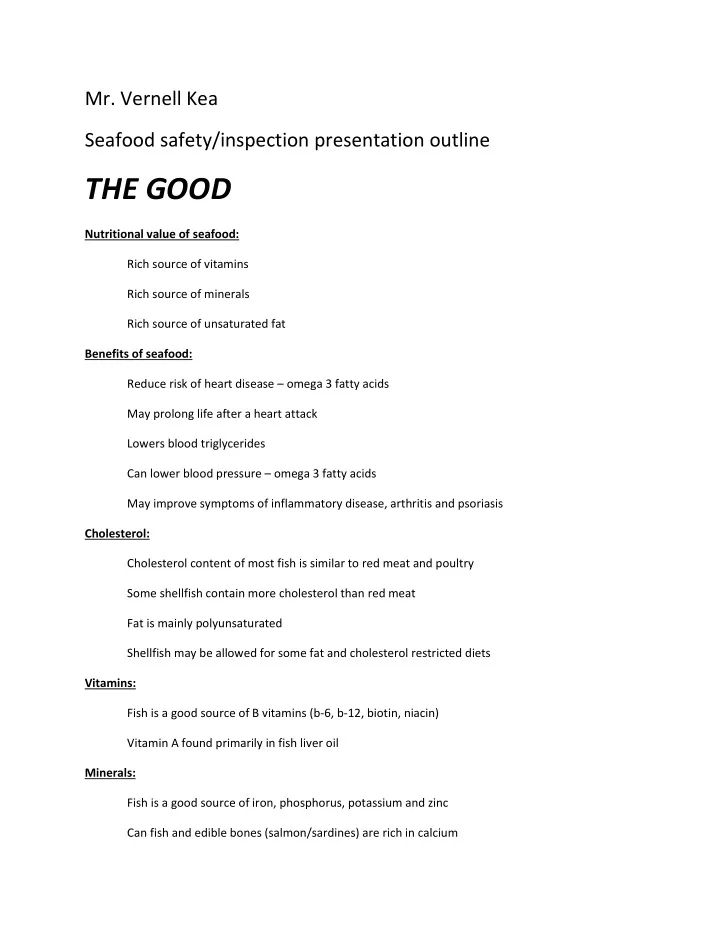

Mr. Vernell Kea Seafood safety/inspection presentation outline THE GOOD Nutritional value of seafood: Rich source of vitamins Rich source of minerals Rich source of unsaturated fat Benefits of seafood: Reduce risk of heart disease – omega 3 fatty acids May prolong life after a heart attack Lowers blood triglycerides Can lower blood pressure – omega 3 fatty acids May improve symptoms of inflammatory disease, arthritis and psoriasis Cholesterol: Cholesterol content of most fish is similar to red meat and poultry Some shellfish contain more cholesterol than red meat Fat is mainly polyunsaturated Shellfish may be allowed for some fat and cholesterol restricted diets Vitamins: Fish is a good source of B vitamins (b-6, b-12, biotin, niacin) Vitamin A found primarily in fish liver oil Minerals: Fish is a good source of iron, phosphorus, potassium and zinc Can fish and edible bones (salmon/sardines) are rich in calcium
THE BAD Mercury: FDA allows a certain level of arsenic, cadmium, lead and mercury in seafood. Mercury released into the air through industrial pollution and lands in the lakes and oceans. Once in the water mercury is turned into methylmercury which is a harmful form of mercury FDA states eating seafood with low levels of methylmercury is not a health concern but fish containing high levels can harm unborn babies or young children’s developing nervous system. FDA advises low seafood consumption for: Women who may become pregnant Women who are pregnant Nursing mothers Young children Seafood high in methylmercury levels: Shark-swordfish-king mackerel-tile fish Seafood low in methylmercury levels: Shrimp-canned light tuna-salmon-pollock-catfish *albacore tuna has more mercury than can light tuna *FDA limits high methylmercury level fish to once a week Journal of exposure science and environmental epidemiology: Performed mercury study in 6 villages of the Tapajos River in the amazon Mercury levels were determined by amount of fish consumption in 256 villagers Mercury levels were very high in only certain villagers Study concluded that villagers with high fruit consumption had lower levels of mercury Shrimp farming: U.S. and Japan import more shrimp than any other country
Shrimps raised on farms/ponds Average pond last approx. 7 years secondary to shrimp waste and chemicals Millions of shrimp crammed together causes stress and they develop white spot syndrome virus which is the leading disease in most shrimp ponds. White spots appear on the body and decompose the shrimp in about 10 days. Stress of overcrowding and white spot syndrome causes shrimp to acquire natural bacteria in coastal waters called vibrio bacteria. If consumed by humans this bacteria can cause gastroenteritis, cholera (small intestine infection), and septic shock. Shrimp producers in Asia and south or Central America are using hefty doses of antibiotics, disinfectants, and pesticides in their shrimp ponds which are all illegal for use in the USA. In order to save the ponds the shrimp are given: Antibiotics: mainly oxytetracycline and ciprofloxin among others. If theses shrimps are consumed it can cause antibiotic resistance in humans. Pesticides: to kill fish, fungi, plants, and insects. If these shrimps are consumed it can cause cancer and neurologic damages to humans FDA is aware of the use of theses in other countries and tries to check some shrimp during import but not enough. U.S. consumers have no way of knowing WHERE the shrimp were imported from because the labeling law only requires seafood sellers to specify if the fish was wild-caught or farmed. 50% of fish in stores have no labels because they are an exception to the labeling law. Seafood that has been processed, boiled, breaded, or added to a seafood medley are exempt from labeling law therefore consumers don’t know where the fish came from nor if it was wild -caught or farmed. Stores and restaurants that carry small amounts of seafood are also exempt from labeling law. FDA and NOAA/inspection: NOAA (national oceanic and atmospheric administration) combined with the FDA to strengthen seafood inspections and improve seafood safety and quality. NOAA inspects products ranging from whole fish to formulated products as well as fish products used for animal foods. FDA rejects seafood to prevent risk of food borne illnesses. Seafood is rejected if:
Not properly transported in cold or sealed containers – seafood not transported under proper refrigeration can develop scombrotoxins and cause histamine poisoning. Decomposed Infected with salmonella Filthy- containing a certain percentage of dirt, insect fragments, rodent hair and fragments. Approximately 400 shipments of tainted seafood is turned away per year by the FDA however only a tiny amount of imports are inspected which is not enough to keep America safe from the dangers of imported seafood. Reason for poor inspection is due to the fact that the FDA needs more funding for inspections of imported seafood. Increased Physical inspection and testing is needed as well to decrease the loop holes in the labeling laws. Tips for selecting seafood: FISH: Should be refrigerated or properly displaced on a thick bed of non-melting ice in a case or under some type of cover. Firm with shiny flesh, should spring back when it’s pressed Bright red gills free from slim Should smell fresh not fishy or sour or ammonia like Eyes should be clear and bulge a little Should be no darkening or drying around the edges Should have no green/yellow discolorations. SHELLFISH: Don’t select cracked/ broken shellfish Perform a tap test on live clams, oysters and muscles. They should close up when u tap on the shell. Check for leg movement with live lobsters and crabs because they spoil rapidly after death.
Recommend
More recommend